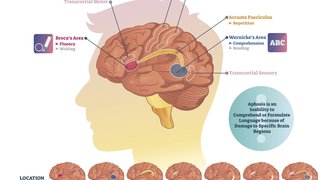How Glen’s journey to getting a power wheelchair got much smoother
December 19, 2023
Glen Denehie is a substitute teacher, soccer fanatic, home cook, and dad of two busy teens. He also has facioscapulohumeral muscular dystrophy (FSHD), one of 30 forms of muscular dystrophy.
FSHD is a genetic disorder that progressively deteriorates the muscles of the feet, shoulders, and face. By age 50, about 20% of people with this condition need a wheelchair to keep moving.

Glen is in his 50s, and his ability to stand and walk is limited, so he decided it was time to replace his motorized scooter with a more accessible power wheelchair. Without it, he would often be at the mercy of loved ones to get around.
After a long and less-than-ideal experience trying to get a chair at a community durable medical equipment (DME) clinic, Glen was almost ready to give up. Then he was referred to UT Southwestern's Wheelchair Seating and Mobility Clinic under the Department of Physical Medicine & Rehabilitation.
"That was a turning point for me,” Glen said. “Working with Dr. Shah’s team has cut months off my expected wait time for a chair. And the best part – which I wish more areas of medicine could replicate – is that they brought all the people I needed to talk to into the same room, at the same appointment.”
UT Southwestern’s Wheelchair Seating and Mobility Clinic streamlines the process and emphasizes full-circle communication, so patients get the wheelchair or mobility device they need more quickly. The clinic has grown from a few patients per month in 2013 to more than 50 a month today.
We’ve developed a standard of patient service that DME vendors across the country are implementing to connect patients with their ideal chair and reduce wait times. We’ve also advocated for patients and played an instrumental role in the recent expansion of Medicare coverage for seat-elevation systems in power wheelchairs, which can be vital tools to help patients with their daily activities and to live independently.
Glen has called our approach to care, which is based on the following three core methods, life changing. We call it the way things should be done to help patients.
1. Integrating tech and medical expertise
Certified assistive technology providers (ATPs) are specially trained to help people with disabilities find the best device – such as a wheelchair or power chair – and teach them how to use the equipment. ATPs are experts in the technical aspects of mobility devices, such as:
- Manual and power wheelchair measurement and fitting.
- Appropriate cushion selection and seating adjustments.
- Fine-tuning features such as seat elevators, positioning aids, eye-gaze controls, and speech recognition technology.
Most clinics have at least one ATP. UT Southwestern has three, from three different wheelchair companies: National Seating & Mobility, Numotion, and Metroplex-based Healthline. And if patients are already working with a DME company, they are welcome to bring their own ATP.
Our ATPs are trained and vetted to ensure they bring ethics and accountability, along with expertise, to every patient visit. They manage a wide selection of trial wheelchairs, so patients can explore how specific equipment looks and feels, and they offer in-home trials for patients within a five-hour radius of the Metroplex. Patients can also visit our DME warehouse to see the different choices for wheelchairs, cushions, and other valuable features.
Having ATPs in-house reduces the number of appointments patients need. They can see me and their ATP in one visit. The one-stop-shop method lets us:
- Ask high-level and specific questions in one conversation.
- Cover medical, technical, and lifestyle concerns in one discussion.
- Reduce redundancy in topics and paperwork.
“I loved that they were able to bring those multi-appointment experiences into one or two visits,” Glen said. “I was not the middleman in my care anymore.”
2. Communicating clearly with vendors and patients
Getting a new wheelchair can be a lengthy process. It requires careful evaluations and measurements and managing insurance claims. In many clinics, patients and staff are left waiting months for a status update on their order.
At UTSW, we’ve created a communication plan that keeps patients, families, and DME vendors on the same page about each case and order. Our process has been so successful that vendors across the U.S. are using it with their clinical partners. The two-pronged process goes like this:
- UTSW clinicians meet regularly with DME vendor leadership. We talk through each patient’s documentation, so we can identify issues and streamline the process. The same nurse works with the same DME rep to review wheelchairs in progress.
- Our DME vendors keep patients in the loop. Patients can get weekly status updates through an app, text, or phone call. After the chair is delivered, the ATP manages the go-between messages with the DME for repairs and tuneups.
Clear and proactive communication has demystified what happens behind the scenes, and the built-in efficiencies often mean patients can get their chairs weeks sooner than they would through a traditional DME clinic.
“Dr. Shah asked me, ‘What can we do? What are your challenges? What do you need?’ and the ATP jumped in with specifics,” Glen said. “The team narrowed down the overwhelming amount of options to what I needed for work, recreation, and just life.”
3. One cohesive care team
Everyone at our clinic plays an important role in caring for the more than 300 patients we see annually. Our multidisciplinary team of nurses, physical therapists, and ATPs meets each month to better understand patients’ needs, the nuances of ever-changing insurance coverage, and how we can continue to put patients first.
As a doctor who cares for patients living with mobility-limiting conditions such as multiple sclerosis and ALS, I’ve seen the toll ill-fitting wheelchairs can take on patients and caregivers, from pressure ulcers to skeletal deformities such as scoliosis. I’ve witnessed the sadness and isolation of losing mobility to a health condition – and the frustration when it feels as if no one is listening, let alone helping.
A core principle of our clinic is that wheelchairs are so much more than durable medical equipment – they are a necessity that can give people with disabilities a more independent life. And people deserve access to the right wheelchair as quickly as possible.
Glen wanted to share his perspective on how our clinic helped him get the most out of work, play, and dad life.
'With my new chair, I don’t have to try cooking at eye level with the stovetop. I’m able to reach more shelves in the kitchen (where we keep the good snacks!) and join my friends at the high-top tables in our favorite restaurants.'
Glen Denehie
The perfect chair: Rising to the occasion
By Glen Denehie
When I was 19, I got in a pretty bad car accident. Although I was young and otherwise healthy, my recovery was taking longer than expected and I was starting to have weakness in my arms and legs. Several years later, I was diagnosed with FSHD, which runs in my family. Right then and there, I promised myself FSHD wasn’t going to take over my life. I would do everything I wanted to do, just differently.
FSHD doesn’t hit you all at once; it’s a gradual deterioration of muscle strength that affects every patient differently. For most of 30 years, I could stand and walk, relying on a scooter for specific situations. In the last few years, the disease progressed to the point where I needed the scooter all the time.

At age 52, I decided I needed a suitable power chair. I am a substitute teacher at my son’s high school, and I want to teach full time. I could get around OK in the scooter without rearranging the room when I subbed, but to teach full time I needed better mobility to manage my own classroom.
I tried ordering a chair through another clinic a few years ago, which was frustrating. Ultimately, I didn’t get the chair and I also spent a lot of time and money going to fruitless appointments. I was hesitant to try again. But from the first visit with Dr. Shah and her team, I knew they were different.
For example, I mentioned that I can only reach halfway up the blackboard at work from the seat of my scooter, so the ATP showed me options for elevating power chairs to extend my reach. With my new chair, I don’t have to try cooking at eye level with the stovetop. I'm able to reach more shelves in the kitchen (where we keep the good snacks!) and join my friends at the high-top tables in our favorite restaurants.
Even better, I’m able to get more involved with my favorite sport: soccer. It’s been tough to navigate unpaved terrain at my kids’ games on the scooter. Dr. Shah’s team helped me choose features in my new chair that allow me to go off-road. And I’m not going to be just a spectator. I plan to join a United States Power Soccer Association league in Dallas, so I can play, too!
One thing I really admired about Dr. Shah is that she’s not just a physician, she's an advocate. She’s the only doctor in the Independence Through Enhancement of Medicare and Medicaid (ITEM) Coalition – an alliance that advocates for policies to improve life for people with disabilities.
Dr. Shah’s work with ITEM recently resulted in expanded coverage of seat-elevation systems in power chairs for people on Medicare. They worked for five years to persuade the Centers for Medicare & Medicaid Services that seat elevation is not just a convenience but is medical in nature for people who need to be able to improve their reach or ability to transfer between surfaces. The technology will enhance quality of life for many people, including me.
Dr. Shah also told me about the Texas Workforce Commission, which is an organization that connects disabled people with resources to get much-needed mobility equipment. TWC worked with me to get some of the funding for the chair and a wheelchair accessible van. I wouldn’t have known about them without seeing Dr. Shah.
I received my new chair in November 2023. Working with the UT Southwestern team cut months off my expected wait time. They made the path to getting my power wheelchair with seat elevation – and a more independent future – truly painless.
Contact UT Southwestern's Wheelchair Seating and Mobility Clinic by calling 214-645-2080.











